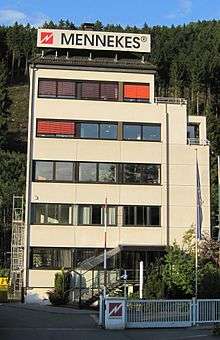Mennekes
_logo2015.png) | |
| GmbH & Co. KG | |
| Founded | 1935 |
| Headquarters | Kirchhundem, Germany |
Area served | Worldwide |
Key people | Walter Mennekes, Christopher Mennekes, Volker Lazzaro, Christoph Epe, Michael Buenfeld |
| Products | Industrial plugs and connectors |
| In 2015 the MENNEKES-group generated consolidated revenue of 130 Million Euros | |
Number of employees | 1000 worldwide |
| Website | www.mennekes.de |

Mennekes Elektrotechnik GmbH & Co. KG is a leading manufacturer of industrial plugs and connectors with headquarters in Kirchhundem/Sauerland region and in Neudorf/Erzgebirge.
The Mennekes company was founded in 1935 when Aloys Mennekes received the master craftsmen senior electrician certificate and set up his own business. Today Mennekes has over 1000 employees worldwide and generates a consolidated revenue of about €130 million. The company's headquarter is still in Kirchhundem in the south of Sauerland with additional factories in Neudorf/Erzgebirge (Sehmatal community) and Nanjing (China). Mennekes has 16 offices in Germany, 80 offices worldwide and a number of international co-operations.[1] The owner and current managing director is Walter Mennekes who is also board member of the Zentralverband Elektrotechnik- und Elektronikindustrie .[2]
The roots of the factory business live in the "Glühauf" invention (a wall-mounted lighter) made after the war that allowed to open the first manufacturing factory in 1948. Shortly later in 1951 an aluminium casting metalworks was added, which functioned as foundation of a fabric that nowadays manufactures over 11,000 different products – including all standardized plugs and various industrial variants.
Mennekes connector
Although being a well known producer in the industrial sector for decades, the Mennekes company became better known to general public for their compliant Electric vehicle car recharging connector developed by Mennekes with requirements from RWE and Daimler. Mennekes had a background in the design of charging couplers based on the IEC 60309 standard (CEEform plugs) including variants like the CEEplus that included additional signal wires.[3] During the initial presentations in 2009 the new connector had been referenced after its creator and only manufacturer as the "Mennekes design" plug.[4] The actual specification was published formally by VDE in the VDE-AR-E 2623-2-2 publication. Two years later the specification was taken over by the international IEC 62196 as "Type 2" connector but the original nickname is kept in informal conversations. As the term Mennekes Connector is ambiguous Mennekes itself uses the term in press coverage along with a clarification as "Type 2"[5]
With the introduction of the first electric cars in the UK they were initially able to connect to the electricity grid with using a 3-pin domestic socket or a "Type 1" connection as it was developed in the USA as SAE J1772. The ACEA (organisation of European automobile makers) however settled on the "Type 2" connector that allows access to the 3-phase power grid.[6] The UK Department for Transport agreed with the position and funding for charging stations favours the Type 2 connector.[7] Many charging point manufacturers are beginning to include a "Type 2 Mode 3" (Mennekes type) socket in addition to a domestic 3-pin socket on their products.
References
- ↑ Mennekes/Company. Website of Mennekes Elektrotechnik GmbH & Co. KG . Accessed 13 October 2010.
- ↑ ZVEI: Board. Website of ZVEI - Zentralverband Elektrotechnik- und Elektronikindustrie e.V.. Accessed 07 August 2018.
- ↑ "Internationaler Standard für das Laden von Elektrofahrzeugen - Schlussbericht", Bundesamt für Energiewirtschaft (Switzerland), 12 December 2001
- ↑ Xavier Navarro (2009-05-20). "The European standard charging plug for cars is selected after Mennekes design". Autoblog Green. Retrieved 2010-04-15.
- ↑ "EU-Energiekommissar Günther Oettinger beeindruckt von Mennekes Ladesteckvorrichtungen". Mennekes Facebook page. 7 April 2011. Retrieved 2012-01-24.
als Typ 2 bezeichneten Ladesteckvorrichtungen von Mennekes
- ↑ "ACEA position and recommendations for the standardization of the charging of electrically chargeable vehicles" Archived 2011-07-06 at the Wayback Machine., ACEA Brussels, 14 June 2010
- ↑ "Making the Connection - The Plug-In Vehicle Infrastructure Strategy" (PDF). Office for Low Emission Vehicles - Department for Transport. June 2011. Archived from the original (pdf) on 2012-01-31. Retrieved 2012-01-05.
External links
- Company website mennekes.de